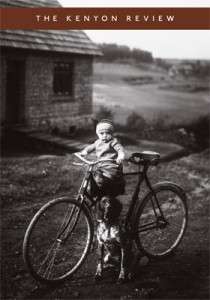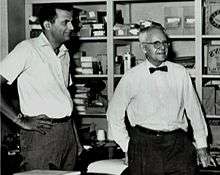The Kenyon Review
 | |
| Discipline | literary journal |
|---|---|
| Language | English |
| Edited by | David H. Lynn |
| Publication details | |
| Publisher | |
Publication history | 1939-present |
| Frequency | Quarterly |
| Indexing | |
| ISSN |
0163-075X |
| JSTOR | 0163075X |
| Links | |
The Kenyon Review is a literary magazine based in Gambier, Ohio, US, home of Kenyon College. The Review was founded in 1939[1][2] by John Crowe Ransom, critic and professor of English at Kenyon College, who served as its editor until 1959. The Review has published early works by generations of important writers, including Robert Penn Warren, Ford Madox Ford, Robert Lowell, Delmore Schwartz, Flannery O'Connor, Boris Pasternak, Bertolt Brecht, Peter Taylor, Dylan Thomas, Anthony Hecht, Maya Angelou, Rita Dove, Derek Walcott, Thomas Pynchon, Woody Allen, Louise Erdrich, William Empson, Linda Gregg, Mark Van Doren, Kenneth Burke, and Ha Jin.[3]
The magazine's short stories have won more O. Henry Awards than any other nonprofit journal—most recently, two in 2004. Many poems that first appeared in the quarterly have been reprinted in The Best American Poetry series, and the magazine is one of the most frequent sources for the series, where poems originally in The Kenyon Review have appeared in the editions for 1992, 1993, 1994, 1996, 1997, 1998, 2001, 2002, 2003, and 2006.
Masthead
- Editor: David H. Lynn, professor of English at Kenyon College[4]
- Advisory Board: David Bergman, Robb Forman Dew, E.L. Doctorow, Daniel Mark Epstein, Alice Fulton, Amitav Ghosh, Rachel Hadas, Michael S. Harper, John Hollander, Lewis Hyde, Allison Joseph, Rebecca McClanahan, Reginald McKnight, Joyce Carol Oates, Wyatt Prunty, Mary Jo Salter, Michael Wood
The magazine also employs Kenyon students as student associates and interns.
History

The magazine was started in 1939.[5] During his 21-year tenure as head of the magazine, John Crowe Ransom made it, according to the magazine's Web site, "perhaps the best known and most influential literary magazine in the English-speaking world during the 1940s and '50s".[3]
In 1959 Robie Macauley succeeded Ransom as editor of The Kenyon Review,[6][7] where he published fiction and poetry by John Barth, T. S. Eliot, Nadine Gordimer, Robert Graves, Randall Jarrell, Richmond Lattimore, Doris Lessing, Robert Lowell, V. S. Naipaul, Joyce Carol Oates, Frank O'Connor, V. S. Pritchett, Thomas Pynchon, J. F. Powers, Karl Shapiro, Jean Stafford, Christina Stead, Peter Taylor, and Robert Penn Warren,[8][9] as well as articles, essays and book reviews by Eric Bentley, Cleanth Brooks, R. P. Blackmur, Malcolm Cowley, Richard Ellmann, Leslie Fiedler, Martin Green, and Raymond Williams. During Macauley's tenure The Kenyon Review published the first reviews in English of Tristes Tropiques and A Clockwork Orange.[10]
A decade after Ransom left the magazine, in 1969, Kenyon College closed it down as its reputation dropped and financial burdens continued. In 1979, however, the quarterly was started up again. Marilyn Hacker, a poet, became the magazine's first full-time editor. "She quickly broadened the quarterly's scope to include more minority and marginalized viewpoints," according to the magazine.[3]
In April 1994, the college trustees directed that costs be cut and revenues increased in various ways. Hacker left and an English professor at the college, David H. Lynn (acting editor in 1989–1990), took over on a two-thirds time basis. The publication's finances have stabilized and improved, and a Kenyon Review Board of Trustees has been set up.[3]
The Kenyon Review Short Fiction Prize,[11] established in 2008, is awarded annually to writers under the age of thirty. The inaugural contest, judged by novelist Alice Hoffman, was won by Cara Blue Adams; Nick Ripatrazone and Megan Mayhew Bergman were named runners-up.[12]
See also
Notes
- ↑ "Top 50 Literary Magazine". EWR. Retrieved August 17, 2015.
- ↑ "Top 50 Literary Magazines and Metazines". Web Del Sol. Retrieved February 10, 2016.
- 1 2 3 4 "History" the Kenyon Review Web site, Retrieved January 26, 2007
- ↑ David H. Lynn
- ↑ Eric L. Haralson (January 21, 2014). Encyclopedia of American Poetry: The Twentieth Century. Routledge. p. 402. ISBN 978-1-317-76322-2. Retrieved December 4, 2015.
- ↑ "Education: Ransom Harvest", Time, May 12, 1958.
- ↑ A John Crowe Ransom Chronology
- ↑ "End of the Kenyon?" Time, Mar 9, 1970.
- ↑ "Robie Macauley" (obituary), Toledo Blade, Nov 22, 1995, p. 12.
- ↑ Berman RS. "Macauley's 'Kenyon Review' the View from the Sixties." The Sewanee Review 1979;87 (3): 500–507.
- ↑ The Kenyon Review Short Fiction Prize
- ↑ April 2008 KR Newsletter